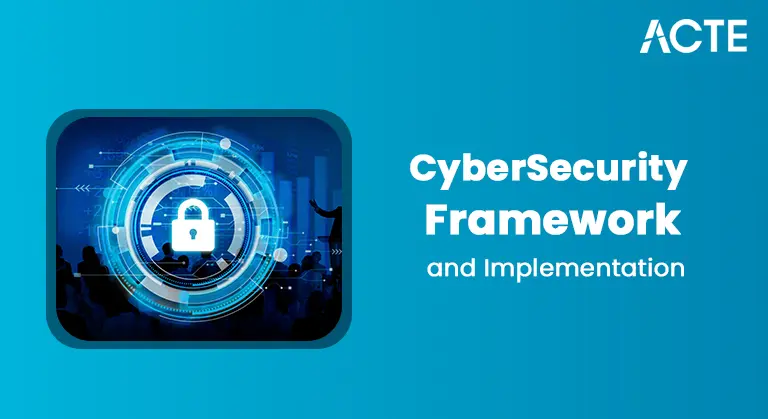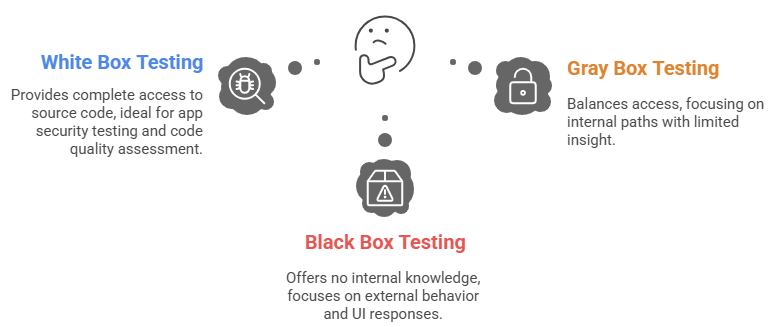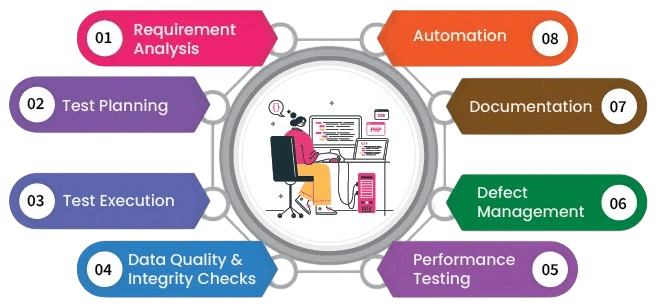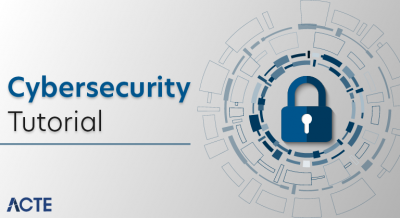
- Definition of White Box Testing
- How It Differs from Black Box and Gray Box
- Objectives of White Box Pen Testing
- Information Shared with the Tester
- Tools and Techniques Used
- Steps in a White Box Penetration Test
- Benefits of White Box Testing
- Limitations and Challenges
Definition of White Box Testing
White Box Testing, also known as clear box or structural testing, is a method used in software and security testing where the internal structure, design, and implementation of the system are fully known to the tester. This approach enables testers to analyze code logic, identify security flaws, and verify the flow of inputs and outputs through the system. In the context of Cyber Security Penetration Testing, White Box Penetration Testing plays a vital role, as it allows ethical hackers to simulate an insider attack by using full knowledge of the system’s architecture, credentials, source code, and configuration files. This approach is also a key component of Cyber Security Training, helping professionals understand how internal threats can be exploited and how to build more secure systems from the inside out. Unlike black box testing, which mimics an external attack, white box testing is more thorough and proactive, identifying hidden vulnerabilities that could be exploited by malicious actors. It is often used in white box security testing to ensure applications are not only functional but also secure at the foundational level. This method is especially beneficial during software development or when compliance with security standards is required. By incorporating white box techniques, organizations can strengthen their security posture, minimize risk exposure, and ensure that their systems can withstand both internal and external threats effectively.
Interested in Obtaining Your Cybercrime Certificate? View The Cyber Security Online Training Offered By ACTE Right Now!
How It Differs from Black Box and Gray Box
- Level of Access: White Box testing provides complete access to source code, system architecture, and configuration data. Black Box testing offers no internal knowledge, while Gray Box testing provides partial information. This access level directly impacts how deeply the tester can assess the system.
- Testing Focus:White Box focuses on code quality and internal logic, ideal for app security testing. Black Box evaluates external behavior, such as UI responses and input/output handling. Gray Box balances both, focusing on internal paths with limited insight. Understanding these testing methods is crucial for identifying vulnerabilities that could be exploited through various types of malware attacks, including ransomware, trojans, and logic bombs, making comprehensive testing an essential part of any cybersecurity strategy.
- Use of Penetration Tools: All three types can use automated penetration tools, but White Box often combines them with code analysis. Black Box relies more heavily on tool-driven penetration scanning, while Gray Box uses tools guided by partial insider knowledge.
In the realm of security testing, understanding the distinctions between White Box, Black Box, and Gray Box approaches is essential for choosing the right strategy based on risk, access level, and testing goals. Each method provides unique insights and uses different levels of system knowledge to uncover vulnerabilities. Here’s how they differ:

- Realism of Attack Simulation: Black Box simulates a real-world external attacker, making it useful for high-level threat detection. Gray Box mimics an insider with limited access. White Box is ideal for internal manual pen testing that targets deep code-level flaws.
- Time and Resource Requirements: White Box is time-intensive due to the depth of analysis, while Black Box is faster but may miss internal issues. Gray Box strikes a balance in resource use and vulnerability discovery.
- Accuracy and Coverage: White Box offers high accuracy with detailed reports, uncovering logic errors and hidden bugs. Black Box may miss certain flaws, and Gray Box provides moderate coverage, useful when time and access are limited.
Each method serves a purpose, and in many cases, a combination of all three approaches yields the most comprehensive security testing results.
Objectives of White Box Pen Testing
The primary objectives of White Box Penetration Testing revolve around thoroughly evaluating the internal workings of a system to identify security flaws, logic errors, and potential vulnerabilities before malicious actors can exploit them. This testing approach provides complete transparency, allowing testers to analyze source code, configuration settings, backend systems, and user access controls. One key objective is to ensure that critical systems are resilient against insider threats and misconfigurations that may not be detected through surface level testing. This aligns closely with the principles taught in Introduction To Bug Bounty Programs, where ethical hackers are encouraged to dig deeper into system vulnerabilities much like in White Box testing to uncover flaws that traditional methods might overlook. Unlike external-only approaches, white box security testing goes deeper into the application or infrastructure, validating whether the implemented security controls are functioning as intended. Another objective is to improve the security development lifecycle by offering developers and engineers detailed feedback on insecure coding practices, poor access controls, or flawed logic. In the broader scope of Cyber Security Penetration Testing, white box testing helps reduce the risk of data breaches, ensures compliance with industry standards, and builds a stronger defense posture from within the system. Additionally, it supports informed decision-making by producing detailed reports and actionable insights, helping organizations proactively address weaknesses rather than reacting after an attack. Overall, white box testing ensures systems are secure not just from the outside, but also structurally sound from within.
To Explore Cybersecurity in Depth, Check Out Our Comprehensive Cyber Security Online Training To Gain Insights From Our Experts!
Information Shared with the Tester
- Source Code Access: Testers receive full access to the application’s source code, enabling precise app security testing by analyzing logic errors, insecure coding patterns, and hidden vulnerabilities.
- Network and Infrastructure Diagrams: Diagrams of the internal network and system architecture help testers understand communication flows, making it easier to simulate real-world attacks using both automated penetration tools and manual methods. Such skills are often emphasized in Cyber Security Training, where professionals learn to interpret architectural layouts and apply them effectively during penetration testing scenarios.
- Configuration Files and System Settings: Details such as server configurations, firewall settings, and access control policies are shared, helping testers identify misconfigurations that could be exploited during manual pen testing.
In White Box Penetration Testing, the tester is given complete visibility into the system’s internal architecture to conduct thorough security testing. This transparency allows for a deep assessment of potential vulnerabilities, logic flaws, and code-level issues that external testing might miss. The following are the key types of information typically shared with the tester:

- User Credentials and Access Roles: Providing login credentials for various user roles allows the tester to evaluate privilege escalation risks and access control weaknesses during penetration scanning.
- API Documentation and Endpoints: Access to APIs and integration points ensures testers can test for insecure endpoints and data exposure vulnerabilities relevant in app security testing.
- Logs and Audit Trails: Logs provide insight into system behavior and past anomalies, which help in identifying patterns or blind spots that may be targeted during security testing.
- Information Gathering: The tester collects all available data, including source code, configuration files, network architecture, and user roles. This foundational step ensures a clear understanding of the system before using any penetration tools.
- Threat Modeling and Planning: Based on gathered data, testers identify potential threat vectors and plan test scenarios. This includes mapping attack surfaces and selecting relevant penetration scanning techniques to simulate realistic threats. During this phase, understanding Encryption and Decryption Concepts is also critical, as testers must evaluate how well sensitive data is protected in transit and at rest, ensuring that cryptographic implementations are properly configured and not vulnerable to exploitation.
- Static Code Analysis: Using automated scanners and manual review, the source code is examined for security flaws, poor coding practices, and logic errors essential for deep app security testing.
- Configuration and Access Control Review: Testers manually assess system configurations, access controls, and user permissions to uncover misconfigurations or privilege escalation paths a critical step in manual pen testing.
- Vulnerability Exploitation: Using both automated tools and custom scripts, testers attempt to exploit identified vulnerabilities in a controlled environment, mimicking real-world attack scenarios.
- Reporting and Remediation Guidance: A detailed report is prepared outlining discovered issues, risk levels, and recommended fixes. This step is vital for improving overall security testing processes and reinforcing system integrity.
Tools and Techniques Used
In White Box Penetration Testing, a variety of advanced tools and techniques are employed to thoroughly examine the internal structure of an application or system. These tools are specifically designed to analyze source code, configurations, and logic flows to detect potential security weaknesses before they can be exploited. Common techniques include static application security testing (SAST), code review, and fault injection, which help identify flaws in authentication, authorization, and data handling processes. Tools such as SonarQube, Veracode, and Checkmarx are widely used in white box security testing to scan for insecure coding practices and logical errors within the codebase. In addition, debuggers and code analyzers are used to trace application behavior during execution, while linters ensure code consistency and highlight risky constructs. These practices are often emphasized in Certified Cloud Security Professional training, where professionals are taught to apply such tools effectively in secure code analysis, especially within complex cloud environments. Unlike black box methods, white box testing allows integration of these tools with developer environments, enabling continuous cyber security penetration testing throughout the software development lifecycle. Manual techniques also play a key role, as ethical hackers often simulate insider threats by leveraging full access to internal documentation, system architecture, and user credentials. This comprehensive approach ensures that all security layers, from code to configuration, are rigorously tested, making white box testing a powerful strategy for proactive cyber defense.
Looking to Master Cybersecurity? Discover the Cyber Security Expert Masters Program Training Course Available at ACTE Now!
Steps in a White Box Penetration Test
A White Box Penetration Test is a structured process that allows testers to examine internal components of a system for vulnerabilities using both automated and manual techniques. With full access to system internals, the process becomes more in-depth compared to other forms of security testing. Below are the key steps involved:
Benefits of White Box Testing
White Box Testing offers significant advantages in the field of security testing by providing comprehensive insight into the internal workings of an application or system. Unlike other testing methods, it allows testers to access source code, architecture diagrams, and configuration files, enabling a thorough examination for vulnerabilities that might be missed through external testing alone. This depth of analysis enhances the effectiveness of app security testing, ensuring that code-level flaws, logic errors, and insecure configurations are identified early in the development lifecycle. It also supports stronger Vulnerability Management Concepts by enabling organizations to detect, prioritize, and remediate security weaknesses proactively, reducing the risk of exploitation in production environments. Utilizing advanced penetration tools alongside manual code reviews and manual pen testing techniques, testers can detect subtle weaknesses such as improper input validation and authentication bypass, and privilege escalation. Furthermore, penetration scanning in white box testing is more targeted and efficient since testers have full knowledge of the system, reducing false positives and uncovering complex vulnerabilities. This approach not only strengthens the security posture but also helps organizations comply with industry standards and regulations by proactively addressing risks before deployment. By integrating White Box Testing into routine security assessments, companies gain a clearer understanding of their system’s internal risks and build more resilient applications, ultimately minimizing the chance of costly breaches and ensuring robust protection against both internal and external threats.
Preparing for Cyber Security Job Interviews? Have a Look at Our Blog on Cyber Security Interview Questions and Answers To Ace Your Interview!
Limitations and Challenges
While White Box Penetration Testing offers deep insight into system vulnerabilities, it also comes with certain limitations and challenges that organizations must consider. One of the primary drawbacks is the significant time and resource investment required to thoroughly analyze source code, system architecture, and internal configurations. This makes white box testing more complex and labor-intensive compared to other cyber security penetration testing methods. Additionally, the success of the test heavily relies on the quality and completeness of the documentation and code provided; outdated or incomplete data can lead to gaps in testing. There’s also the risk of overwhelming testers with too much information, which can reduce focus and efficiency. Moreover, white box testing may miss certain real-world attack vectors that a malicious outsider without insider knowledge might exploit, making it important to complement it with other testing types. This limitation is often addressed in Cyber Security Training, where professionals are taught to balance detailed internal analysis with external threat simulation to ensure a well-rounded security strategy. In some cases, ethical concerns may arise if the testers have access to sensitive or proprietary data. Despite being a powerful white box security testing approach, it may not be suitable for all scenarios, especially when time is limited or full access to internal data isn’t feasible. Therefore, organizations must weigh these challenges carefully and often adopt a hybrid approach for more balanced and comprehensive security assurance.




